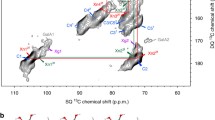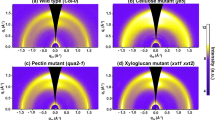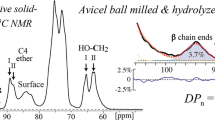Abstract
Acidification of plant primary cell walls causes cell wall expansion and plant growth. To understand how acidic pH affects the molecular structure and dynamics of wall polysaccharides, we have now characterized and compared Arabidopsis thaliana primary cell walls in neutral (pH 6.8) and acidic (pH 4.0) conditions using solid-state NMR spectroscopy. Quantitative 13C solid-state NMR spectra indicate that the pH 4.0 cell wall has neutral galacturonic acid residues in homogalacturonan (HG) and rhamnogalacturonan (RG). 13C INEPT spectra, which selectively detect highly dynamic polymers, indicate that some of the HG and RG chains in the interfibrillar region have become more dynamic in the acidic wall compared to the neutral cell wall, whereas other chains have become more rigid. Consistent with this increased dynamic heterogeneity, C–H dipolar couplings and 2D 13C–13C correlation spectra indicate that some of the HG backbones are partially aggregated in the acidic cell wall. Moreover, 2D correlation spectra measured with long mixing times indicate that the acidic cell wall has weaker cellulose–pectin interactions, and water-polysaccharide 1H spin diffusion data show that cellulose microfibrils are better hydrated at low pH. Taken together, these results indicate a cascade of chemical and conformational changes of wall polysaccharides due to cell wall acidification. These changes start with neutralization of the pectic polysaccharides, which disrupts calcium crosslinking of HG, causes partial aggregation of the interfibrillar HG, weakens cellulose–pectin interactions, and increases the hydration of both cellulose microfibrils and matrix polysaccharides. These molecular-level structural and dynamical changes are expected to facilitate polysaccharide slippage, which underlies cell wall loosening and expansion, and may occur both independent of and as a consequence of protein-mediated wall loosening.
Graphical abstract







Similar content being viewed by others
Abbreviations
- Ara, A:
-
Arabinose
- CW:
-
Cell wall
- CP:
-
Cross polarization
- DP:
-
Direct polarization
- Gal:
-
Galactose
- GalA, GA:
-
Galacturonic acid
- HG:
-
Homogalacturonan
- INEPT:
-
Insensitive nuclei enhanced by polarization transfer
- i:
-
Interior crystalline cellulose
- MAS:
-
Magic-angle spinning
- PDSD:
-
Proton-driven 13C–13C spin diffusion
- RG-I:
-
Rhamnogalacturonan I
- Rha R:
-
Rhamnose
- SSNMR:
-
Solid-state nuclear magnetic resonance
- s:
-
Surface amorphous cellulose
- XyG:
-
Xyloglucan
- Xyl, x:
-
Xylose
References
Arsuffi G, Braybrook SA (2018) Acid growth: an ongoing trip. J Exp Bot 69:137–146
Bielecki A, Kolbert AC, Levitt MH (1989) Frequency-switched pulse sequences—homonuclear decoupling and dilute spin NMR in solids. Chem Phys Lett 155:341–346
Bosch M, Hepler PK (2005) Pectin methylesterases and pectin dynamics in pollen tubes. Plant Cell 17:3219–3226
Braybrook SA, Peaucelle A (2013) Mechano-chemical aspects of organ formation in Arabidopsis thaliana: the relationship between auxin and pectin. PLoS ONE 8:e57813
Cadars S et al (2007) The refocused INADEQUATE MAS NMR experiment in multiple spin-systems: interpreting observed correlation peaks and optimising lineshapes. J Magn Reson 188:24–34
Cavalier DM et al (2008) Disrupting two Arabidopsis thaliana xylosyltransferase genes results in plants deficient in xyloglucan, a major primary cell wall component. Plant Cell 20:1519–1537
Cosgrove DJ (2000) Loosening of plant cell walls by expansins. Nature 407:321–326
Cosgrove DJ (2005) Growth of the plant cell wall. Nat Rev Mol Cell Biol 6:850–861
Cosgrove DJ (2016) Catalysts of plant cell wall loosening. F1000Res 5:1–13
Cosgrove DJ (2018) Diffuse growth of plant cell walls. Plant Physiol 176:16–27
Cosgrove DJ, Bedinger P, Durachko DM (1997) Group I allergens of grass pollen as cell wall-loosening agents. Proc Natl Acad Sci USA 94:6559–6564
Dick-Perez M, Zhang YA, Hayes J, Salazar A, Zabotina OA, Hong M (2011) Structure and interactions of plant cell wall polysaccharides by two- and three-dimensional magic-angle-spinning solid-state NMR. Biochemistry 50:989–1000
Durachko DM, Cosgrove DJ (2009) Measuring plant cell wall extension (creep) induced by acidic pH and by alpha-expansin. J Vis Exp 25:1263
Elena B, Lesage A, Steuernagel S, Bockmann A, Emsley L (2005) Proton to carbon-13 INEPT in solid-state NMR spectroscopy. J Am Chem Soc 127:17296–17302
Ezaki N, Kido N, Takahashi K, Katou K (2005) The role of wall Ca2+ in the regulation of wall extensibility during the acid-induced extension of soybean hypocotyl cell walls. Plant Cell Physiol 46:1831–1838
Hager A (2003) Role of the plasma membrane H+-ATPase in auxin-induced elongation growth: historical and new aspects. J Plant Res 116:483–505
Hager A, Menzel H, Krauss A (1971) Experiments and hypothesis concerning the primary action of auxin in elongation growth. Planta 100:47–75
Hediger S, Emsley L, Fischer M (1999) Solid-state NMR characterization of hydration effects on polymer mobility in onion cell-wall material. Carbohydr Res 322:102–112
Hong M, Gross JD, Rienstra CM, Griffin RG, Kumashiro KK, Schmidt-Rohr K (1997) Coupling amplification in 2D MAS NMR and its application to torsion angle determination in peptides. J Magn Reson 129:85–92
Kohn R, Kovac P (1978) Dissociation-constants of D-galacturonic and D-glucuronic acid and their O-methyl derivatives. Chem Pap 32:478–485
Laskowski M, Biller S, Stanley K, Kajstura T, Prusty R (2006) Expression profiling of auxin-treated Arabidopsis roots: toward a molecular analysis of lateral root emergence. Plant Cell Physiol 47:788–792
Lesage A, Auger C, Caldarelli S, Emsley L (1997) Determination of through-bond carbon–carbon connectivities in solid-state NMR using the INADEQUATE experiment. J Am Chem Soc 119:7867–7868
Liepinsh E, Otting G (1996) Proton exchange rates from amino acid side chains–implications for image contrast. Magn Reson Med 35:30–42
Lüthen H, Bigdon M, Böttger M (1990) Reexamination of the acid growth theory of auxin action. Plant Physiol 93:931–939
Majda M, Robert S (2018) The role of auxin in cell wall expansion. Int J Mol Sci 19:1–21
Mcqueen-mason SJ, Cosgrove DJ (1995) Expansin mode of action on cell-walls—analysis of wall hydrolysis, stress-relaxation, and binding. Plant Physiol 107:87–100
Munowitz MG, Griffin RG, Bodenhausen G, Huang TH (1981) Two-dimensional rotational spin-echo nuclear magnetic-resonance in solids—correlation of chemical-shift and dipolar interactions. J Am Chem Soc 103:2529–2533
Park YB, Cosgrove DJ (2012a) Changes in cell wall biomechanical properties in the xyloglucan-deficient xxt1/xxt2 mutant of arabidopsis. Plant Physiol 158:465–475
Park YB, Cosgrove DJ (2012b) A revised architecture of primary cell walls based on biomechanical changes induced by substrate-specific endoglucanases. Plant Physiol 158:1933–1943
Phyo P, Wang T, Kiemle SN, O’Neill H, Pingali SV, Hong M, Cosgrove DJ (2017a) Gradients in wall mechanics and polysaccharides along growing inflorescence stems. Plant Physiol 175:1593–1607
Phyo P, Wang T, Xiao C, Anderson CT, Hong M (2017b) Effects of pectin molecular weight changes on the structure, dynamics, and polysaccharide interactions of primary cell walls of Arabidopsis thaliana: insights from solid-state NMR. Biomacromol 18:2937–2950
Prat R, Gueissaz MB, Goldberg R (1984) Effects of Ca-2+ and Mg-2+ on elongation and H+ secretion of vigna radiata hypocotyl sections. Plant Cell Physiol 25:1459–1467
Rienstra CM et al (2002) De novo determination of peptide structure with solid-state magic-angle spinning NMR spectroscopy. Proc Natl Acad Sci USA 99:10260–10265
Tepfer M, Cleland RE (1979) A comparison of acid-induced cell wall loosening in valonia ventricosa and in oat coleoptiles. Plant Physiol 63:898–902
Wang T, Hong M (2016) Solid-state NMR investigations of cellulose structure and interactions with matrix polysaccharides in plant primary cell walls. J Exp Bot 67:503–514
Wang T, Zabotina O, Hong M (2012) Pectin–cellulose interactions in the Arabidopsis primary cell wall from two-dimensional magic-angle-spinning solid-state nuclear magnetic resonance. Biochemistry 51:9846–9856
Wang T, Park YB, Caporini MA, Rosay M, Zhong LH, Cosgrove DJ, Hong M (2013) Sensitivity-enhanced solid-state NMR detection of expansin’s target in plant cell walls. Proc Natl Acad Sci USA 110:16444–16449
Wang T, Salazar A, Zabotina OA, Hong M (2014) Structure and dynamics of Brachypodium primary cell wall polysaccharides from two-dimensional 13C solid-state nuclear magnetic resonance spectroscopy. Biochemistry 53:2840–2854
Wang T, Park YB, Cosgrove DJ, Hong M (2015) Cellulose–pectin spatial contacts are inherent to never-dried Arabidopsis thaliana primary cell walls: evidence from solid-state NMR. Plant Physiol 168:871–883
Wang T, Chen Y, Tabuchi A, Hong M, Cosgrove DJ (2016a) The target of beta-expansin EXPB1 in maize cell walls from binding and solid-state NMR studies. Plant Physiol 172:2107–2119
Wang T, Phyo P, Hong M (2016b) Multidimensional solid-state NMR spectroscopy of plant cell walls. Solid State Nucl Magn Reson 78:56–63
White PB, Wang T, Park YB, Cosgrove DJ, Hong M (2014) Water-polysaccharide interactions in the primary cell wall of Arabidopsis thaliana from polarization transfer solid-state NMR. J Am Chem Soc 136:10399–10409
Xiao C, Zhang T, Zheng Y, Cosgrove DJ, Anderson CT (2016) Xyloglucan deficiency disrupts microtubule stability and cellulose biosynthesis in Arabidopsis, altering cell growth and morphogenesis. Plant Physiol 170:234–249
Yu B, van Ingen H, Vivekanandan S, Rademacher C, Norris SE, Freedberg DI (2012) More accurate 1 J(CH) coupling measurement in the presence of 3 J(HH) strong coupling in natural abundance. J Magn Reson 215:10–22
Acknowledgments
This research was supported by the Center for Lignocellulose Structure and Formation, an Energy Frontier Research Center funded by the U.S. Department of Energy, Office of Science, Basic Energy Sciences under Award # DE-SC0001090.
Author information
Authors and Affiliations
Corresponding author
Rights and permissions
About this article
Cite this article
Phyo, P., Gu, Y. & Hong, M. Impact of acidic pH on plant cell wall polysaccharide structure and dynamics: insights into the mechanism of acid growth in plants from solid-state NMR. Cellulose 26, 291–304 (2019). https://doi.org/10.1007/s10570-018-2094-7
Received:
Accepted:
Published:
Issue Date:
DOI: https://doi.org/10.1007/s10570-018-2094-7




